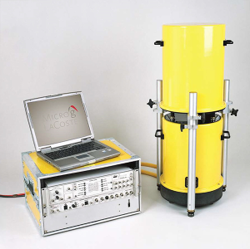4. Contemporary Gravity Measurement
Technology has evolved quite a bit in the last few decades causing maturation of some traditional measurement devices and creating new ones. One of the biggest changes is that measurements aren't limited to terrian-based instruments. Air- and space-borne systems allow greater area coverage than manual point-by-point measurement.
a. Absolute v Relative
There are many gravity data users with diverse accuracy and coverage requirements. Most try to locate and identify subsurface activity which affects gravity in a particular way. Surveyors, on the other hand, collect gravity data to relate to and refine the geoid model.
Absolute gravity measurements is the gravity at a point while relative is between points. Consider gravity stations as the control network for other gravity measurements, much like bench marks are for a leveling circuit. Control is established to a higher level of accuracy than are the surveys which use it. Establishing control often requires special equipment and/or procedures. Such is the case with gravity measurements.
Absolute gravimeters are either pendulum or free-fall instruments, A free-fall instrument measures the time it takes an object to fall a specific distance (was the apple bonking Sir Isaac Newton the first gravimeter?). An instrument used by the NGS is the Micro-g LaCVoste A10 gravimeter, Figure E-5(a). It uses a laser interferometer to monitor a mirror dropped in a vacuum, Figure E-5(b).
 |
 |
| (a) | (b) |
| Figure E-5 Micro-g LaCVose A103 |
|
3 Manufacturer's website: https://microglacoste.com
To establish a gravity station requires 30-60 hours of observations, more if site has highly active gravity.
Absolute instruments can achieve an accuracy of ~1 mgal which corresponds to an elevation difference of about 0.01 ft. Besides determining point gravity, absolute measurements can be used to monitor gravity change at a point.
Because they are used to determine gravitational force at any location on Earth, absolute gravimeters need a large measuring range and must maintain their accuracy throughout the range.
Most relative gravimeters are based on the mass-spring concept, though more sophisticated than earlier versions. They are simpler than absolute instruments because they need only measure the gravity difference between locations which does not require a large measuring range.
b. Airborne Gravity Measurement
A gravimeter mounted in an aircraft provides the ability to measure gravity over large swaths of area. It is an excellent way to fill coverage gaps in terrestrial and shipboard networks. It uses relative gravimetric measurement system.
Figure E-6 is the NGS' relative meter jet platform.
 |
| Figure E-6 NGS Airborne Gravimeter System4 |
4 Airborne Gravity Processing 101, NGS Workshop, Preaux
In addition to the gravimeter, the aircraft has
- an inertial measurement unit (IMU) for orientation
- GPS receivers in the gravimeter and IMU (for positioning)
The platform was used in support of the Gravity for the Redefinition of the American Vertical Datum or GRAV-D. The collected gravity measurements would be used to help define GEOID2022 for the new horizontal and vertical datum redefinitions.
c. Satellite-Based
Gravity Recovery and Climate Experiment (GRACE) was a paired satellite system launched by NASA in 2002 and intended to collect gravity data for 5 years.
The two identical satellites (nicknamed Tom and Jerry), Figure E-7, approximately 137 miles apart orbited the Earth 15 times a day. The distance between them was constantly monitored.
 |
| Figure E-7 GRACE Satellites 5 |
5 NASA/Jet Propulsion Laboratory, https://www.jpl.nasa.gov/
The satellites would speed up or slow down relative to each as the pull of gravity changed, affecting the distance between them. Using GPS for positioning, even small gravity variations could be accurately located.
In 2017 with one satellite's batteries failing, the mission was officially terminated, outliving its project timeframe by 10 years. GRACE was so successful and the data so useful that GRACE-FO (Follow On) was launched in 2018 for another 5 year mission. NASA announced that GRACE-C (Continuity) is planned to launch in 2028.